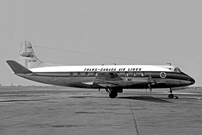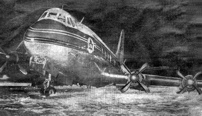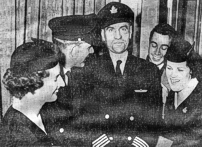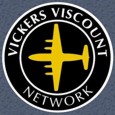
March 1955 to March 1964
Trans-Canada Air Lines (TCA)
CF-TGM - c/n 50 - a V.724 series Viscount
Canada registered
November 1952
An order was placed by Trans-Canada Air Lines (TCA) for fifteen Type 724 aircraft at a total cost of Can$11,500,000. This was the fifth one built.
Production Aircraft No. 51 - the 51st production Type 700 series Viscount built,
was the 18th Viscount fuselage assembled at Hurn, Bournemouth, Hampshire, England,
and the 23rd Viscount assembled at Hurn, Bournemouth, Hampshire, England.
Production Order No. F05/724. Sales Order No. F05/51B. Stock Order No. F19/21B.
27 July 1954
Fuselage assembly commenced at Hurn Airport, Bournemouth, Hampshire, England.
29 September 1954
Fuselage to Erecting Shop 'E' at Hurn Airport, Bournemouth, Hampshire, England.
15 March 1955
First flight from Hurn Airport, Bournemouth, Hampshire, England.
It was fitted with Rolls-Royce Dart RDa3 Mark 506 engines.
21 March 1955
TCA issued technical instruction V-05.04-1/1 to apply the word 'Viscount' to the tail section in 8.5 inch high red letters edged in white at the first opportunity.
29 March 1955
Aircraft passed off by TCA inspectors as completed and ready for delivery.
30 March 1955
Departed from Hurn Airport, Bournemouth, Hampshire, England on delivery to Trans-Canada Air Lines (TCA) with fleet number '605'.
After refuelling at Prestwick Airport, Ayrshire, Scotland it then flew on to Keflavik Airport, Iceland (743 nautical miles) for another refuelling stop.
Departed from Keflavik Airport, Iceland to Bluie West One (BW1) Airfield, Narsarsuaq, Southern Greenland (804 nautical miles), Goose Bay Airport, Newfoundland & Labrador, Canada (672 nautical miles) where it stopped overnight.
BW1 was built during WWII to assist the transfer of military aircraft from North America to Europe and was opened in January 1942.
This was the first of the fleet to have the word 'Viscount' on the tail in the upper position.
31 March 1955
Departed from Goose Bay Airport, Newfoundland & Labrador, Canada to Dorval International Airport, Montreal, Province of Quebec, Canada (810 nautical miles).
The cabin seating was installed in Canada, as the seats used by TCA were of American manufacture.
The cabin was fitted out with 40 seats which was a reduction from the original 48 seat specification and provided more leg room.
This was heavily marketed and resulted in a high load factor compared to the 18 seat Douglas DC-3 that it replaced on some routes.
2 June 1955
TCA issued technical instruction V-31.02-2/5 to apply the word 'Viscount' to the inside of the passenger loading door in 4 inch high red letters edged in white at the first opportunity.
July 1956
Cabin interior changed to a two class 44 seat arrangement.
10 July 1957
TCA issued instructions that all Viscounts would be repainted in a later 'White Top' livery when a suitable maintenance period became available.

Later 'White Top' livery
5 May 1958
Scheduled to enter the Winnipeg Airport, Manitoba, Canada TCA maintenance facility for the replacement of the life expired wing lower inner spar boom at approximately 5830 landings for this component. This work usually took 28 days to complete.
10 September 1959
Suffered an electrical failure. No more details known so please contact information@vickersviscount.net if you can help.
31 August 1960
Total time 13,820 hours and 10,694 total landings.

Made an emergency landing
9 February 1962
Made an emergency landing at Dorval International Airport, Montreal, Province of Quebec, Canada.
After departing from Malton Airport, Toronto on a flight to Uplands Airport, Ottawa the flight crew discovered that there was a malfunction to the port main undercarriage. Captain C P 'Chuck' Kenworthy elected to divert to Dorval International Airport, Montreal where there were more facilities and landed with the starboard and nosewheel legs down and locked. He managed to keep the port wing level for much of the landing run until the speed decayed. This resulted in minimal damage to the aircraft but the port propellers curled on impact resulting in shockload damage to the two Dart engines.
There were no serious injuries to the 44 passengers and 5 crew on board. Note the increase in seating from 40.
Photographs by La Presse, Montreal show the aircraft on the runway and others of Captain Kenworthy being congratulated by the other crew members, Co-pilot D A Stanger, hostesses Cynthia Davis and Shirley Bostock inside the terminal building.
Prior to this incident the standard procedure in the event of a main undercarriage leg problem was that the aircraft should be landed on its belly. Based on the small amount of damage incurred during this incident the procedure was changed to allow a single main leg landing to be attempted at the discretion of the Captain.
The cause of the undercarriage leg failure was a loss of hydraulic oil caused by broken 'D' type seals in the main strut. The leg did not fully retract after takeoff which allowed it to become trapped by the closing undercarriage doors. Replacement 'V' type seals were fitted and a fleetwide instruction was put out to replace existing 'D' type seals on other affected aircraft at the earliest convenience.

Captain Kenworthy and his crew
14 April 1962
Returned to service after repairs including replacement port engines and propellers.
12 January 1963
Withdrawn from service and stored at Winnipeg Airport, Manitoba, Canada.
Total time 18,151 hours and 14,701 total landings.
2 March 1964
Sold to William C Wold & Associates.
|



